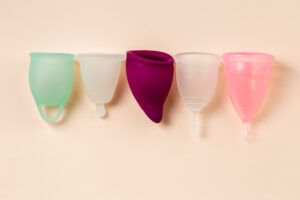Women are becoming more aware of this eco-friendly alternative to pads and tampons. But what exactly is a menstrual cup?
The small, flexible cup is made of silicone or latex rubber. Most cups are made of silicone. There is one cup available that is made of rubber called the Keeper Cup. Instead of absorbing your flow, like a tampon or pad, it catches and collects it. It looks like a little rubber bell with a stem coming out of the top of the bell. Some cups have a ball or ring instead of the stem. The advantage of the stem is that, if the stem is too long, it can be trimmed down.
To use a menstrual cup, you tightly fold the menstrual cup and insert it like a tampon without an applicator. Some cups are softer than others so they are easier to fold. One thing to remember is, if the cup is very soft, it can collapse more easily once placed in the vagina so you may have more leakage. Used correctly, you shouldn’t feel the cup. It’s similar to putting a diaphragm or birth control ring in place.
Your cup will spring open and rest against the walls of your vagina. It forms a seal to prevent leaks. The blood then simply drips into the cup.
Most cups are reusable. To remove it, you pull the stem sticking out the bottom and pinch the base to release the seal. Then you just empty, wash with soap and water, and replace. At the end of your cycle, you can sterilize your cup in boiling water, unless the manufacturer specifically advises against boiling their product. MeLuna brand comes with a little cleaning brush. Although some manufacturers will recommend using bleach or hydrogen peroxide to clean the cup between periods, these chemicals will break down silicone. There are also special washes for menstrual cups available, but really all you need is hand wash and warm water to clean the cup during your periods.
Like any other product for your period, you can buy them online or over the counter at drugstores.
Are Menstrual Cups New?
Menstrual cups have actually been around since the 1930s, but America was slow to catch on. The first menstrual cup for U.S. use was manufactured in 1987.
Even if you can’t use or don’t need to use a menstrual cup, you can consider donating a menstrual cup to someone else! There is an organization that began in 2015 called The Cup Foundation. It is a California based non-profit organization with a mission to empower underprivileged girls worldwide by providing them with sustainable menstrual cups and comprehensive education on sexuality and reproductive rights. As stated on their website, thecup.org, “in 2015 UNICEF and the World Health Organization estimated that at least five hundred million women lack sufficient resources to manage their periods. With insufficient menstrual solutions, many girls miss a week of school each month or they drop out for good. Too often these girls even engage in transactional sex to make money for pads and tampons.” I urge you to visit the website and see how this organization is helping young women worldwide to stay in school and achieve their dreams.
Pros
It’s eco- and wallet-friendly. A reusable cup that costs $30 to $40 can last up to 10 years. That means less waste in landfills and less money over time. These benefits don’t apply to disposable brands though. The cost to buy pads or tampons is around $60-$120 per year.
You can leave it in for 12 hours. Tampons need to be changed every 4 to 8 hours, depending on your flow. But cups can stay in longer, so they’re good for overnight protection. And once you get the hang of inserting it, there’s no need to wear a backup pad or liner. When first learning how to use the cup, wearing a parti-liner or pad is advised.
It holds more. A menstrual cup can hold 1 ounce of liquid, roughly twice the amount of a super-absorbent tampon or pad. The difference can be a comfort on your heavy flow days. The average person usually loses 35-50 ml of blood over a 3-5 day period. The smaller cups hold about 25 ml and the larger cups hold 30 ml. Those who have menorrhagia, which is very heavy period flow, lose 80 ml or more of blood during the course of the period. So even those with menorrhagia can use a cup but it will just involve changing the cup more often, which is also true when using tampons.
You can have mess-free sex. Most silicone and rubber menstrual cups must be removed before sex. But a menstrual DISC can be kept in during sex. They look like a diaphragm, so they’re shaped like a dome rather than the bell shape of a cup. Your partner can’t feel them, and there’s no blood to worry about. Menstrual discs come in reusable and disposable forms. The Softdisc is a disposable option. The disc sits high up in the vagina and covers the cervix. It looks very much like a diaphragm. Removal requires that you insert your fingers higher into the vagina. It is NOT the best option for someone with a low cervix.
There’s less odor. Menstrual blood can start to smell when it’s exposed to air. But your cup forms an airtight seal.
Easy to pack. The cup is great for travelers and backpackers. It’s a much more compact option than a box of tampons or pads.
Cons
It can be tricky to find the right fit. Although there are different sizes available to accommodate different ages, heaviness of flow, and whether you’ve had a child, finding the perfect fit can be a challenge, more so if you have a tilted uterus or low cervix. It can take some trial and error, and you could have leaks in the meantime. One brand that comes in several sizes is MeLuna. Their website even includes a size calculator . The MeLuna Shorty is a good option for those who have a low cervix. For long vaginas, the DivaCup brand is a good choice. If you have a wider vagina, the Lena Cup is worth a try.
One way to determine how high your cervix is, you can insert a finger into the vagina and if you cannot feel the cervix at all, you have a high cervix. If you insert your finger all the way into the vagina and you feel the cervix, a medium size would likely work best for you. If you do not have to insert your finger all the way into the vagina to feel the cervix then you have a low cervix. The cervix feels firm, much like the tip of your nose.
Removal can get messy — or embarrassing. Even if you find it easy to insert the cup, removing it can be tricky. In a sit or squat, you need to use your pelvic floor muscles to push the cup down, then reach up and grab the stem. Pinch the base to break the seal and angle the cup slightly back to keep it from spilling.
And if you’re in public, keep in mind you’ll need to wash out the cup in the restroom sink. (As an alternative, one manufacturer suggests bringing a bottle of water with you into the stall and rinsing it out, then wiping clean with toilet paper or a baby wipe.) MeLuna has Stall Wipes to use when you are on the go.
It could interfere with an IUD. Some manufacturers don’t recommend using a menstrual cup if you have an intrauterine device (IUD) inserted, as there’s a chance the cup could pull on the string or dislodge it when inserting or removing the cup. However, a 2012 study found no evidence of this. Still, I recommend that you talk to the practitioner who provides your GYN care before starting use of the menstrual cup.
There is an excellent NY Times article with a comprehensive review of menstrual cups and discs. If you are interested in starting use of one of these devices I strongly encourage you to read this very informative piece in its entirety.




